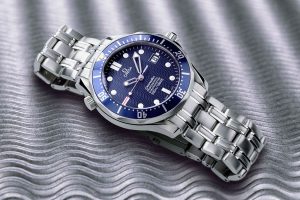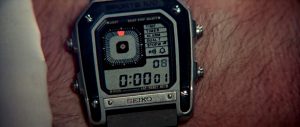Extremely rare 1962 AOPA 24 hour ‘Navitimer’ ref 809, later known as the ‘Cosmonaute’ with wide bezel.
How the Mercury astronauts came into possession of the Breitling Cosmonaute watches is not totally clear. There is the possibility that NASA issued these watches or that they were simply gifted by Breitling. With the 809 intended to become the official watch of the Mercury program either is possible.

The Breitling Navitimer reference 809 (no Cosmonaute wording) with 24 hour all Black dial and wide beaded bezel, commonly referred to as the ‘Scott Carpenter’. This same version of the 1962 Navitimer was famously worn by Carpenter on the NASA Mercury Space Missions and became the first Swiss Chronograph in Space.
Carpenter had been involved in helping Breitling develop the Cosmonaute model after becoming fond of the Navitimer chronographs he had seen on the wrists of Air Force pilots and suggested modifications that could be applied to better suit Space travel for the Mercury mission.
The modifications included – Firstly to re-calibrate the Venus 178 movement to show on a 24-hour dial. The 90-minute orbit of the crew resulted in frequent changes from light to dark and this would make it easier to keep track of time.
Whilst there is the obvious change to the numbered markers on the dial to show a full 24 hours the slide rule is also simplified with the removal of the Hours: Minutes scale thought to be of no use travelling in Space.
The beaded bezel was made wider, tapering outwards to make it easier for the bezel to be operated and rotated whilst wearing gloves. Giving the original 809 it’s unique and iconic look and making the overall watch now measures 42.5mm versus the standard Navitimer at circa 40.5mm.
Malcom Scott Carpenter

Malcom Scott Carpenter’s Breitling Navitimer 809 Cosmonaute
Malcom Scott Carpenter (May 1, 1925 – October 10, 2013), is the reason why we have the Breitling Cosmonaute as we know it today. He was one of the original astronauts selected to be part of NASA’s Project Mercury in April of 1959, After wearing his 12-hour Navitimer during his time as a combat pilot in the Korean War, he suggested that Breitling produce a Navitimer with a 24-hour dial. Breitling registered the name “Cosmonaute” in 1961, and in 1962, a modified Navitimer with a 24-hour dial was the first Breitling to go to space. The Cosmonaute was manufactured in the early to mid-1960s with various dial configurations, bezel combinations, logos, and metals, and all were powered by the Venus 178 movement. Among the numerous variations that were produced, this example has the two-plane logo with the name “Cosmonaute” in gilt color, which adds to the charm of the overall look.
John Glenn

John Glenn’s Breitling Navitimer 809 Cosmonaute
John Glenn Jr. was a United States Marine Corps aviator, engineer, astronaut, and politician. Becoming the first American to orbit the Earth, circling it three times in 1962. Before joining NASA, Glenn was a distinguished fighter pilot in World War II and was awarded six Distinguished Flying Crosses and eighteen Air Medals.
He was one of the Mercury Seven, military test pilots selected in 1959 by NASA as the nation’s first astronauts. On 20th February 1962, Glenn flew the Friendship 7 mission, becoming the first American to orbit the Earth. He received the NASA Distinguished Service Medal in 1962, the Congressional Space Medal of Honor in 1978, was inducted into the U.S. Astronaut Hall of Fame in 1990 and received the Presidential Medal of Freedom in 2012.
Share this:
- Click to share on Facebook (Opens in new window)
- Click to share on Twitter (Opens in new window)
- Click to print (Opens in new window)
- Click to share on LinkedIn (Opens in new window)
- Click to share on Reddit (Opens in new window)
- Click to share on Tumblr (Opens in new window)
- Click to share on Pinterest (Opens in new window)
- Click to share on Pocket (Opens in new window)
- Click to share on Telegram (Opens in new window)
- Click to share on WhatsApp (Opens in new window)




